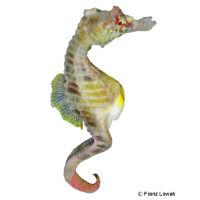Pot-bellied Seahorse (Hippocampus abdominalis)
| Pot-bellied Seahorse Hippocampus abdominalis | |
|---|---|
| Name | Pot-bellied Seahorse |
| Name Lat. | Hippocampus abdominalis |
| Synonym | Hippocampus bleekeri |
| Family | Pipefishes & Seahorses |
| Family lat. | Syngnathidae |
| Order | Pipefishes & Seahorses |
| Order lat. | Syngnathiformes |
| Origin | SW-Pacific |
| Habitat | Protected bays |
| Diet | Carnivore |
| pH | 8.1-8.4 |
| Hardness | 8-10 °KH |
| Behavior | Peaceful |
| Keeping | Pair, group |
| Reef Compatible | Yes |
| Care Level | Difficult |
| Life Span | 3-5 years |
| Protection | CITES Appendix II; EC Annex B |
| Metric Units | |
| Size | 18-35 cm |
| Temperature | 18-24 °C |
| Salinity | 33-36 ‰ |
| Aquarium | ~ 400 l |
| US Units | |
| Size | 7"-14" |
| Temperature | 64-75 °F |
| Salinity | 1.020-1.025 sg |
| Aquarium | ~ 100 gal |
Distribution and habitat
Hippocampus abdominalis are widely distributed from the coast of southeastern Australia to Tasmania and around New Zealand. They prefer to live near the coast, mainly in sheltered bays, on reefs over sandy zones, among sea grass or seaweed.
Maintenance
They need a well structured aquarium with numerous branching structures to hold on to, such as non-netting corals (e.g. horn corals), seaweed, algae (e.g. Caulerpa), plastic tubes etc. and living stones that act like a biological filter and whose microbes serve as additional food for them, as well as sandy areas. Some shaded light and a very weak current is ideal
Only substrates rich in lime and free of heavy metals should be used as substrate. Filters, skimmers and heaters are necessary to ensure water quality, as well as pumps to simulate tides, swells and bottom currents. Lighting must match the species-appropriate day-night rhythm of the animals
| Salinity: 33-36 ‰ | pH value: 8.1-8.4 |
| Carbonate hardness: 8-10 °KH | Nitrate content: 2-8 mg/l |
| phosphate content: 0.01-0.1 mg/l | nitrite content: 0.0-0.05 mg/l |
For salinity, an average value should be aimed for, which may only vary slightly by +/- 0.5 ‰. Ammonia and ammonium must not be measurable. Special attention must be paid to constantly good water quality.
Diet
In nature they feed mainly on zooplankton. The food supply consists of live food, such as mysis, small shrimps and Artemia, which is also well accepted frozen after acclimatization, and a special food mixture enriched with vitamins for plankton eaters
These slow eaters should be fed small portions several times a day
A regular and varied diet promotes health and increases resistance.
Behaviour and compatibility
They are very calm and peaceful fish and only at spawning time males form small territories. They can be socialized with small, calm fish that are not food competitors. However, it is better to keep them in a species tank.
Sex dimorphism
The males have an external papilla, while the females have a very rounded abdomen
Reproduction and breeding
Breeding in the aquarium is often successful. After courtship, the female transfers the eggs into the male's brood pocket. After 20-28 days, the larvae hatch and are released from the brood pocket, ending brood care. Rearing the young is difficult. Suitable food for rearing is live phytoplankton and Artemia nauplii.
Species protection
Species protection: WA Appendix II; EU Appendix B. The proof of purchase is the required proof of origin for the animal. Please keep it safe! Your pet store will be happy to provide you with further information!
Important
The water should definitely be sterilized with a UVC analge, because they are very susceptible to bacterial diseases
If different species are kept together, make sure that the fish match each other in terms of water quality and temperature requirements as well as their social behavior, and that the setup meets the needs of all species kept together. Newly introduced fish must be acclimated slowly to the water in the aquarium
Further literature can be found in your pet store.
References
Text: petdata; Image: Franz Lowak
Source: KUITER, DEBELIUS (2007): Atlas der Meeresfische: Die Fische an den Küsten der Weltmeere, Kosmos Verlag; ENGELMANN (2005): Zootierhaltung - Tiere in menschlicher Obhut: Fische, Verlag Harri Deutsch
- Gemäß § 21 Abs. 5 Tierschutzgesetz idgF
